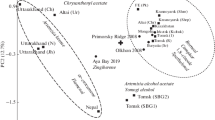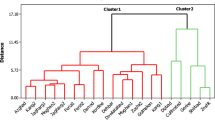Abstract
Artemisia jacutica Drob. (Yakut wormwood) is a biennial plant endemic to Eastern Siberia. This species is distributed across the Republic of Sakha (Yakutia) and southern Central Siberia, colonizing salt meadows and grasslands, steppe areas, saline to sodic surface soil patches, abandoned agricultural lands, and ruderal habitats. The species is rather rare in Buryatia, due to the southeastern frontier of its area. The essential oil of the Yakut wormwood contains chamazulene as a principal compound component with an anti-inflammatory effect. The data generated within the survey and the published statistics indicate that the climatic conditions affect the formation of the essential oil component composition in plants, which is obviously appropriate to provide the best adaptation of the plants to their environmental growing conditions. Therefore, the effects of climatic conditions on the essential oil component composition in the Yakut wormwood plants result in the formation of two chemotypes known as Buryat and Yakut. It has been ascertained that the formation of these chemotypes occurs due to the differences between the rates of heat and moisture supply to the lands favorable for plant growth, expressed by the hydrothermal coefficient (HTC). The temperature–humidity extremeness parameters defining the coefficient based on annual data greatly affect the ratio of components in the essential oil. The climate-related factors (air temperature, precipitation, etc.) and their integrated potential can influence certain constituents and their proportions in the essential oil, affecting their variability.

Similar content being viewed by others
REFERENCES
Anenkhonov, O.A., Pykhalova, T.D., Osipov, K.I., Sekulich, I.R., Badmaeva, N.K., Namzalov, B.B., Krivobokov, L.V., Munkueva, M.S., Sutkin, A.V., Tubshinova, D.B., and Tubanova, D.Ya., Opredelitel’ rastenii Buryatii (Key to Plants of Buryatia), Ulan-Ude: Respublikanskaya Tipografiya, 2001.
Arino, A., Arberas, I., Renobales, G., Arriaga, S., and Dominigues, J.B., Seasonal variation in wormwood (Artemisia absinthium L.) essential oil composition, J. Essent. Oil Res., 2019, vol. 11, no. 5, pp. 619–622.
Atazhanova, G.A., Terpenoidy efirnykh masel rastenii (Terpenoids of Plant Essential Oils), Moscow: ICSPF, 2008.
Babaei, K., Mohammad, M., Farhadi, N., and Pirbalouti, A.G., Morphological, physiological and phytochemical responses of Mexican marigold (Tagetes minuta L.) to drought stress, Sci. Hortic., 2021, vol. 284, p. 110116.
Bazilevich, N.I., Biologicheskaya produktivnost' ekosistem Severnoi Evrazii (Biological Productivity of Ecosystems of Northern Eurasia), Moscow: Nauka, 1993.
Danilova, N.S., Borisova, S.Z., and Ivanova, N.S., Review of Artemisia genus of Central Yakutia, Bull. M.K. Ammosov North-Eastern Fed. Univ., 2011, no. 1, pp. 11–16.
Del Grosso, S., Parton, W., Stohlgren, Th., Zheng, D., Bachelet, D., Prince, S., Hibbard, K., and Olson, R., Global potential net primary production predicted from vegetation class, precipitation, and temperature, Ecology, 2008, vol. 89, no. 8, pp. 2117–2126.
Dylenova, E.P., Randalova, T.E., Tykheev, Zh.A., Zhigzhitzhapova, S.V., and Radnaeva, L.D., Artemisia jacutica Drob. as the source of terpenoids, IOP Conf. Ser.: Earth Environ. Sci., 2019, vol. 320, no. 1, p. 012054.
Dylenova, E.P., Zhigzhitzhapova, S.V., Radnaeva, L.D., and Randalova, T.E., The essential oil composition of Artemisia jacutica Drob. from the flora of Buryatia, Russia, IOP Conf. Ser.: Earth Environ. Sci., 2021a, vol. 908, no. 1, p. 012031.
Dylenova, E.P., Zhigzhitzhapova, S.V., Randalova, T.E., and Radnaeva, L.D., Low-molecular weight metabolites of Artemisia jacutica Drob., Sbornik materialov yubileinoj mezhdunarodnoi nauchnoi konferentsii “90 let – ot rasteniya do lekarstvennogo preparata: dostizheniya i perspektivy” (Collect. Mater. Anniv. Int. Sc. Conf. “90 years – from a Plant to a Drug: Achievements and Prospects”), Moscow: VILAR, 2021b, pp. 407–412.
Dylenova, E.P., Zhigzhitzhapova, S.V., Randalova, T.E., and Radnaeva, L.D., The composition of the essential oil of the East-Siberian endemic Artemisia jacutica Drob., IV Vserossiiskaya nauchnaya konferentsiya s mezhdunarodnym uchastiem “Raznoobrazie pochv i bioty Severnoi i Tsentral’noi Azii” (IV All-Russ. Sci. Conf. Int. Participation “Diversity of Soils and Biota of North and Central Asia”), Ulan-Ude: Buryat. Nauchn. Tsentr Sib. Otd. Ross. Akad. Nauk, 2021c, pp. 150–152.
Forni, C., Duca, D., and Glick, B.R., Mechanisms of plant response to salt and drought stress and their alteration by rhizobacteria, Plant Soil, 2017, vol. 410, pp. 335–356. https://doi.org/10.1007/s11104-016-3007-x
Frank, D.A., Drought effects on above- and belowground production of a grazed temperate grassland ecosystem, Oecologia, 2008, vol. 152, no. 1, pp. 131–139.
Gelman, E., Hill, J., and Vehtari, A., Regression and Other Stories, 2020.
Kalinkina, G.I., Berezovskaya, T.P., Dmitruk, S.E., and Salnikova, E.N., Prospects for the use of essential oil plants of Siberian flora in medical practice, Khim. Rastit. Syr’ya, 2000, no. 3, pp. 5–12.
Khanina, M.A., Serykh, E.A., Berezovskaya, T.P., and Khan, V.A., Essential oils of Artemisia plants of Absinthium DC. section, Khim. Prir. Soedin., 1992, no. 2, pp. 283–284.
Khanina, M.A., Serykh, E.A., Amelchenko, V.P., Pokrovsky, L.M., and Tkachev, A.V., Results of an introduction study of Artemisia jacutica Drob., Khim. Rastit. Syr’ya, 1999, no. 3, pp. 63–78.
Khanina, M.A., Serykh, E.A., Pokrovsky, L.M., and Tkachev, A.V., New data of the chemical composition of the essential oil of Artemisia absinthium L. of the Siberian flora, Khim. Rastit. Syr’ya, 2000, no. 3, pp. 33–40.
Krasnoborov, I.M., Lomonosova, M.N., Tupitsyna, N.N., et al., Flora Sibiri (Flora of Siberia), Asteraceae (Compositae), Novosibirsk: Nauka, Sib. Otd. Ross. Akad. Nauk, 1997, vol. 13.
Mandoulakani, B.A. Eyvazpour, E., and Ghadimzadeh, M., The effect of drought stress on the expression of key genes involved in the biosynthesis of phenylpropanoids and essential oil components in basil (Ocimum basilicum L.), Phytochemistry, 2017, vol. 139, pp. 1–7.
Mohammadi, H., Ghorbanpour, M., and Brestic, M., Exogenous putrescine changes redox regulations and essential oil constituents in field-grown Thymus vulgaris L. under well-watered and drought stress conditions, Ind. Crops Prod., 2018, vol. 122, pp. 119–132.
Pena, E.A. and Slate, E.H., Global validation of linear model assumptions, J. Am. Stat. Assoc., 2006, vol. 101, no. 473, pp. 341–354.
Radwan, A., Kleinwachter, M., and Selmar, D., Impact of drought stress on specialised metabolism: Biosynthesis and the expression of monoterpene synthases in sage (Salvia officinalis), Phytochemistry, 2017, vol. 141, pp. 20–26.
Saratikov, A.S., Prishchep, T.P., Vengerovsky, A.I., Berezovskaya, T.P., Kalinkina, G.I., and Serykh, E.A., Anti-inflammatory properties of essential oils of Asian yarrow and some types of wormwood, Khim.-Farm. Zh., 1986, vol. 20, no. 5, pp. 585–588.
Svoboda, M. and Fuchs, B.A., World Meteorological Organization (WMO) and Global Water Partnership (GWP): Handbook of Drought Indicators and Indices, Geneva: Integrated Drought Management Programme (IDMP), Integrated Drought Management Tools and Guidelines, 2016.
Titlyanova, A.A., Bazilevich, N.I., Snytko, V.A., Dubynina, S.S., Kopoteva, T.A., Magomedova, L.N., Mironycheva-Tokareva, N.P., Nefedyeva, L.G., Semenyuk, N.V., Tishkov, A.A., Tran Tee, Khakimzyanova, F.I., Shatokhina, N.G., and Shmakova, E.I., Biologicheskaya produktivnost' travyanykh ekosistem. Geograficheskie zakonomernosti i ekologicheskie osobennosti (Biological Productivity of Grass Ecosystems. Geographic Patterns and Ecological Features), Novosibirsk: Nauka, Sib. Otd., 1988.
Tkachev, A.V., Issledovanie letuchikh veshchestv rastenii (Study of Volatile Substances of Plants), Novosibirsk, 2008.
Tkachev, A.V., Prokusheva, D.L., and Domrachev, D.V., Dikorastushchie efirnomaslichnye rasteniya Yuzhnoi Sibiri (Wild-Growing Essential Oil Plants of Southern Siberia), Novosibirsk: Offset-TM, 2017.
Verma, N. and Shukla, S., Impact of various factors responsible for fluctuation in plant secondary metabolites, J. Appl. Res. Med. Aromat. Plants, 2015, vol. 2, no. 4, pp. 105–113.
Vysochina, G.I., Biochemical approaches to understanding the diversity of the plant world, Sib. Ekol. Zh., 1999, no. 3, pp. 207–211.
Zhigzhitzhapova, S.V., Randalova, T.E., Radnaeva, L.D., Anenkhonov, O.A., and Zhang, F., Comparative studies on composition of essential oil in three wormwoods (Artemisia L.) from Buryatia and Mongolia, J. Essent. Oil-Bear. Plants, 2015, vol. 18, no. 3, pp. 637–641.
Zhigzhitzhapova, S.V., Radnaeva, L.D., Gao, Q.B., Chen, S.L., and Zhang, F.Q., Chemical composition of volatile organic compounds of Artemisia vulgaris L. (Asteraceae) from the Qinghai-Tibet Plateau, Ind. Crops Prod., 2016, vol. 83, pp. 462–469.
Zhigzhitzhapova, S.V., Randalova, T.E., Radnaeva, L.D., Dylenova, E.P., Chen, S.L., and Zhang, F.Q., Chemical composition of essentials oils of Artemisia frigida Willd. grown in the North and Central Asia, J. Essent. Oil-Bear. Plants, 2017, vol. 20, no. 4, pp. 915–926.
Zhigzhitzhapova, S.V., Dylenova, E.P., Gulaev, S.M., Randalova, T.E., Taraskin, V.V., Tykheev, Zh.A., and Radnaeva, L.D., Composition and antioxidant activity of the essential oil of Artemisia annua L., Nat. Prod. Res., 2020, vol. 34, no. 18, pp. 2668–2671.
Zhigzhitzhapova, S.V., Namzalov, B.-Ts.B., and Radnaeva, L.D., Composition of Essential Oil of Artemisia gmelinii Web. ex Stechm. of Priolkhonian Flora (Lake Baikal), Contemp. Probl. Ecol., vol. 14, no. 1, 2021, pp. 71–78.
Zhuravskaya, A.N., Stogniy, V.V., and Kershengolts, B.M., Dependence of the radiosensitivity of plant seeds on the environmental conditions of growth, Radiats. Biol., Radioecol., 1998, no. 5, pp. 531–539.
Funding
This research survey was carried out as part of State Tasks FWSU-2021-0010 and АААА-А21-121011890027-0 of the Baikal Institute of Nature Management, Siberian Branch, Russian Academy of Sciences (BINM SB RAS), and no. 121030900138-8 of the Institute of General and Experimental Biology, Siberian Branch, Russian Academy of Sciences, based on the Center for Collective Use of Scientific Equipment, BINM SB RAS.
Author information
Authors and Affiliations
Corresponding authors
Ethics declarations
The authors declare that they have no conflict of interests.
Additional information
Translated by O. Zhiryakova
Rights and permissions
About this article
Cite this article
Dylenova, E.P., Zhigzhitzhapova, S.V., Zhigzhitzhapov, B.V. et al. Influence of Climatic Conditions on the Composition of Artemisia jacutica (Asteraceae) Essential Oil. Contemp. Probl. Ecol. 16, 367–378 (2023). https://doi.org/10.1134/S1995425523030046
Received:
Revised:
Accepted:
Published:
Issue Date:
DOI: https://doi.org/10.1134/S1995425523030046




